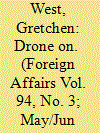| Srl | Item |
| 1 |
ID:
137562


|
|
|
|
|
| Summary/Abstract |
In the beginning, drones were almost exclusively the province of militaries. At first little more than remote-controlled model planes used in the World War I era, military drones advanced steadily over the decades, eventually becoming sophisticated tools that could surveil battlefield enemies from the sky. Today, the terms “drone” and “unmanned aircraft system” denote a vehicle that navigates through the air from point A to point B and is either remotely controlled or flies autonomously. While they vary in size and shape, such vehicles all feature a communications link, intelligent software, sensors or cameras, a power source, and a method of mobility (usually propellers).
|
|
|
|
|
|
|
|
|
|
|
|
|
|
|
|
| 2 |
ID:
127545


|
|
|
|
|
| Publication |
2013.
|
| Summary/Abstract |
As the human spaceflight industry grows the agencies charged with regulating that industry meet significant challenges. An improvement in launch success would improve the safety for the crew and passengers of a commercial human spaceflight. With respect to ELV launches, NASA's regulations over civil launches are mission success oriented while commercial launches regulated by the FAA-AST, the agency that will also be charged with human spaceflight, takes a more public safety oriented stance. A comparison of the launch success between civil and commercial launches is used to inform the decision on whether or not mission success would be an appropriate regulatory stance for the FAA-AST. The results show that there is no significant difference in launch success between civil and commercial ELV launches. Because of this and because the industry is wary of over regulation, there is indication that a mission success oriented stance might not be appropriate for regulating commercial human spaceflight.
|
|
|
|
|
|
|
|
|
|
|
|
|
|
|
|